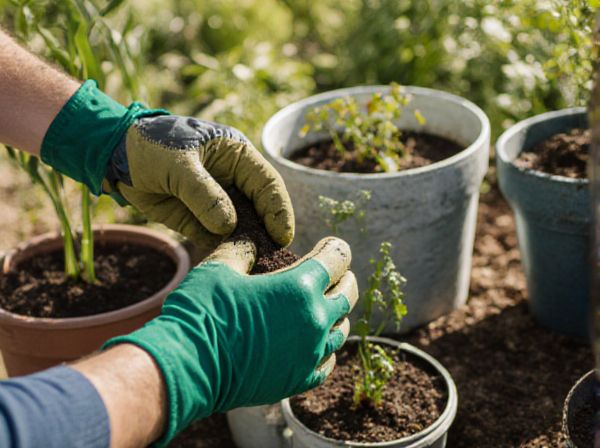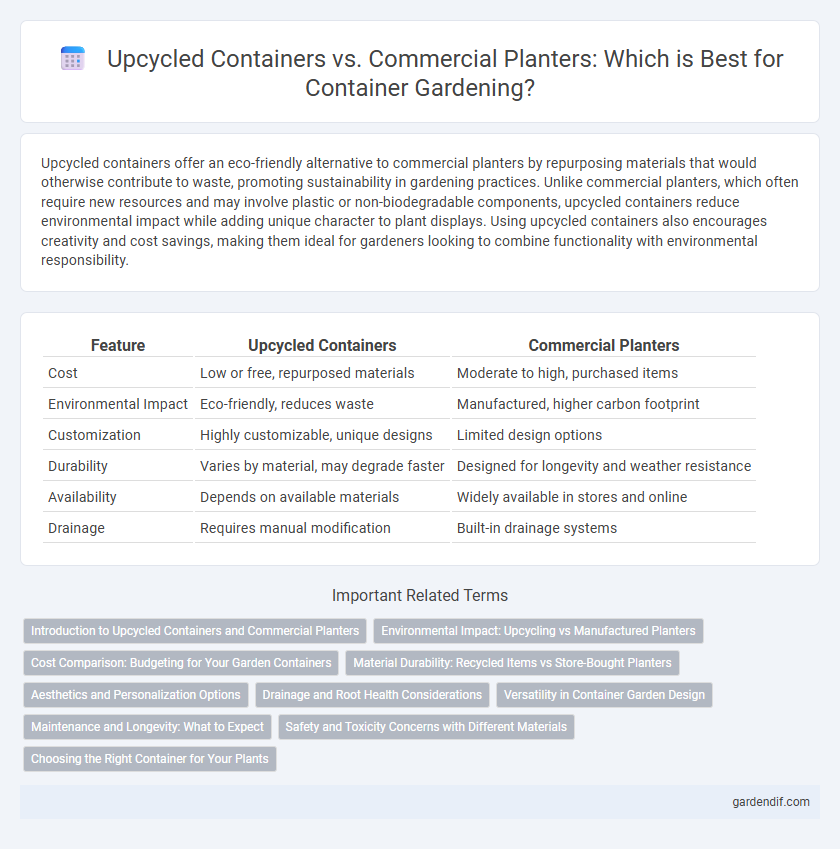
Upcycled containers vs commercial planters Illustration
Upcycled containers offer an eco-friendly alternative to commercial planters by repurposing materials that would otherwise contribute to waste, promoting sustainability in gardening practices. Unlike commercial planters, which often require new resources and may involve plastic or non-biodegradable components, upcycled containers reduce environmental impact while adding unique character to plant displays. Using upcycled containers also encourages creativity and cost savings, making them ideal for gardeners looking to combine functionality with environmental responsibility.
Table of Comparison
| Feature | Upcycled Containers | Commercial Planters |
|---|---|---|
| Cost | Low or free, repurposed materials | Moderate to high, purchased items |
| Environmental Impact | Eco-friendly, reduces waste | Manufactured, higher carbon footprint |
| Customization | Highly customizable, unique designs | Limited design options |
| Durability | Varies by material, may degrade faster | Designed for longevity and weather resistance |
| Availability | Depends on available materials | Widely available in stores and online |
| Drainage | Requires manual modification | Built-in drainage systems |
Introduction to Upcycled Containers and Commercial Planters
Upcycled containers transform discarded materials into functional planters, reducing waste while promoting sustainable gardening practices. Commercial planters, made from materials like plastic, ceramic, or metal, offer durability and varied designs but often rely on new resources and manufacturing processes. Choosing upcycled containers supports environmental conservation by reusing existing items and minimizing the carbon footprint compared to mass-produced commercial options.
Environmental Impact: Upcycling vs Manufactured Planters
Upcycled containers significantly reduce environmental impact by reusing materials that would otherwise become waste, lowering the demand for new raw resources and minimizing landfill contributions. Manufactured planters often involve energy-intensive production processes and the use of non-biodegradable plastics or synthetic compounds, increasing carbon emissions and pollution. Choosing upcycled containers supports circular economy principles, promotes sustainability, and reduces overall ecological footprints compared to conventional commercial planters.
Cost Comparison: Budgeting for Your Garden Containers
Upcycled containers typically offer significant cost savings compared to commercial planters, as they repurpose materials like old buckets, crates, or pallets at little to no expense. Commercial planters, while often aesthetically uniform and durable, can range from $20 to over $100 per unit, increasing total garden setup costs. Budget-conscious gardeners can effectively allocate funds by integrating upcycled containers without sacrificing functionality or style in their garden design.
Material Durability: Recycled Items vs Store-Bought Planters
Upcycled containers often utilize durable materials such as reclaimed wood, metal, or plastic, offering robustness and resistance to weathering comparable to commercial planters made from high-grade ceramics, fiberglass, or treated plastics. While commercial planters are designed for consistent performance and may include UV protection and waterproof coatings, recycled containers can vary widely in longevity depending on the source materials and treatments applied. Careful selection and treatment of upcycled containers can enhance material durability, making them a sustainable alternative to many store-bought options without sacrificing function or lifespan.
Aesthetics and Personalization Options
Upcycled containers offer unique aesthetic appeal through their diverse textures, colors, and creative reuse of materials, making each piece one-of-a-kind. Unlike commercial planters, which often come in standardized designs and limited color palettes, upcycled options provide extensive personalization possibilities, allowing gardeners to tailor their plant displays to fit eclectic or rustic decor themes. Customizing upcycled planters with paint, decals, or additional materials enhances visual interest and reflects individual style preferences far beyond conventional planter designs.
Drainage and Root Health Considerations
Upcycled containers often provide superior drainage options compared to commercial planters by allowing customizable hole placement, which prevents waterlogging and promotes healthier root systems. Commercial planters typically feature standardized drainage holes that may not suit all plant types, potentially leading to root rot or restricted growth. Ensuring adequate drainage in both container types is essential for maintaining oxygen availability and preventing root diseases, directly impacting plant vitality.
Versatility in Container Garden Design
Upcycled containers offer unmatched versatility in container garden design due to their wide range of shapes, sizes, and materials, allowing gardeners to create personalized and unique arrangements. Unlike commercial planters that often come in standardized forms, upcycled containers can be tailored to fit specific plant needs and aesthetic preferences, maximizing both space and creativity. This adaptability makes upcycled containers a sustainable and innovative choice for diverse gardening environments.
Maintenance and Longevity: What to Expect
Upcycled containers often require more frequent upkeep due to potential wear and tear, but they offer excellent longevity when properly treated and sealed against moisture. Commercial planters made from durable materials like fiberglass or resin provide low maintenance and resistance to weathering, extending their lifespan with minimal effort. Choosing between the two depends on balancing environmental benefits of upcycled options with the convenience and durability of commercial products.
Safety and Toxicity Concerns with Different Materials
Upcycled containers often pose safety and toxicity concerns due to unknown chemical residues or paints that can leach harmful substances into soil and plants. Commercial planters are typically made from food-grade or non-toxic materials specifically designed to avoid contaminant transfer, ensuring safer use for growing edible plants. Selecting containers verified for safety standards reduces risks associated with heavy metals, BPA, or other toxic chemicals commonly found in repurposed materials.
Choosing the Right Container for Your Plants
Upcycled containers provide eco-friendly alternatives to commercial planters, often made from recycled materials that reduce waste and lower environmental impact. When choosing the right container for your plants, factors such as drainage, size, and material durability play crucial roles in promoting healthy root growth and plant development. Commercial planters offer standardized designs and specialized features, but upcycled containers can add unique aesthetics and sustainability benefits that appeal to eco-conscious gardeners.
Upcycled containers vs commercial planters Infographic

 gardendif.com
gardendif.com